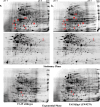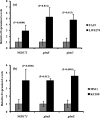Coordinated Transcriptional Increases in Cell Wall Synthesis Genes in Neisseria gonorrhoeae Lacking the Lytic Transglycosylase, ltgA
- PMID: 40327097
- PMCID: PMC12055626
- DOI: 10.1007/s00284-025-04261-7
Coordinated Transcriptional Increases in Cell Wall Synthesis Genes in Neisseria gonorrhoeae Lacking the Lytic Transglycosylase, ltgA
Abstract
Lytic transglycosylase A in Neisseria gonorrhoeae cleaves the β-1,4-glycosidic bond between peptidoglycan (PG) monomers to liberate 1,6-anhydro-PG fragments that are either recycled or released as cytotoxic fragments. To gain further insight into the effect of LtgA on cellular processes in Neisseria gonorrhoeae, we performed a proteomic analysis comparing wild-type and an isogenic ltgA null mutant strain. Proteins were separated by two-dimensional gel electrophoresis and identified by MALDI-TOF mass spectrometry, which revealed several proteins that were increased in their level of expression upon loss of LtgA. The most notable changes corresponded to enzymes related to aminosugar and pyrimidine metabolism. Quantitative real-time RT-PCR of mRNA from a ltgA null strain confirmed increased transcription of genes encoding enzymes involved in UDP-N-acetylglucosamine (UDP-GlcNAc) synthesis, a major precursor in PG and lipooligosaccharide (LOS) synthesis, during normal growth conditions and following exposure to penicillin. We also found that the ltgA mutant strains were more susceptible to β-lactam antibiotics, vancomycin, and the human-cathelicidin antibacterial peptide, LL-37, than their corresponding wild-type parental strains. Our results suggest that increased expression of enzymes responsible for production UDP-GlcNAc is an adaptive response due to inactivation of ltgA and/or exposure to penicillin.
© 2025. The Author(s).
Conflict of interest statement
Declarations. Conflicts of interests: The authors declare there are not conflicts of interests in these areas. Ethical Approval: Not applicable. Consent to Participate: Not required. Consent to Publications: Not required.
Figures








Similar articles
-
Neisseria gonorrhoeae uses two lytic transglycosylases to produce cytotoxic peptidoglycan monomers.J Bacteriol. 2008 Sep;190(17):5989-94. doi: 10.1128/JB.00506-08. Epub 2008 Jun 20. J Bacteriol. 2008. PMID: 18567658 Free PMC article.
-
Lytic transglycosylases LtgA and LtgD perform distinct roles in remodeling, recycling and releasing peptidoglycan in Neisseria gonorrhoeae.Mol Microbiol. 2016 Dec;102(5):865-881. doi: 10.1111/mmi.13496. Epub 2016 Sep 26. Mol Microbiol. 2016. PMID: 27608412 Free PMC article.
-
Neisseria gonorrhoeae Lytic Transglycosylases LtgA and LtgD Reduce Host Innate Immune Signaling through TLR2 and NOD2.ACS Infect Dis. 2017 Sep 8;3(9):624-633. doi: 10.1021/acsinfecdis.6b00088. Epub 2017 Jun 21. ACS Infect Dis. 2017. PMID: 28585815 Free PMC article.
-
The lytic transglycosylases of Neisseria gonorrhoeae.Microb Drug Resist. 2012 Jun;18(3):271-9. doi: 10.1089/mdr.2012.0001. Epub 2012 Mar 20. Microb Drug Resist. 2012. PMID: 22432703 Free PMC article. Review.
-
Attention Seeker: Production, Modification, and Release of Inflammatory Peptidoglycan Fragments in Neisseria Species.J Bacteriol. 2017 Sep 19;199(20):e00354-17. doi: 10.1128/JB.00354-17. Print 2017 Oct 15. J Bacteriol. 2017. PMID: 28674065 Free PMC article. Review.
References
-
- Chesson HW, Kent CK, Owusu-Edusei K Jr, Leichliter JS, Aral SO (2012) Disparities in sexually transmitted disease rates across the “Eight Americas.” Sex Transm Dis 39(6):458–464. 10.1097/OLQ.0b013e318248e3eb - PubMed
-
- Azariah S, Perkins N (2007) Risk factors and characteristics of patients with gonorrhoea presenting to Auckland sexual health service, New Zealand. N Z Med J 120(1252):U2491 - PubMed
-
- Wasserheit JN (1992) Epidemiological synergy. interrelationships between human immunodeficiency virus infection and other sexually transmitted diseases. Sex Transm Dis 19:61–77 - PubMed
MeSH terms
Substances
Grants and funding
LinkOut - more resources
Full Text Sources

